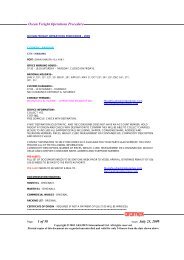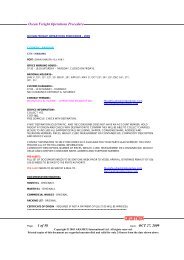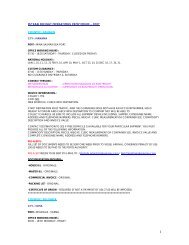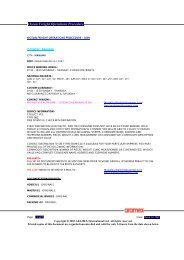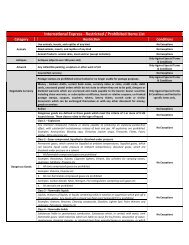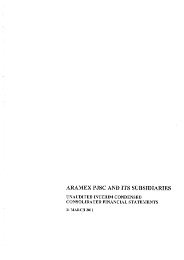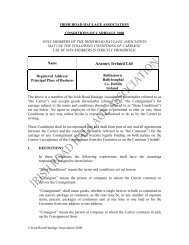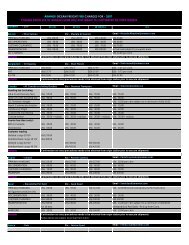Annual - Aramex
Annual - Aramex
Annual - Aramex
You also want an ePaper? Increase the reach of your titles
YUMPU automatically turns print PDFs into web optimized ePapers that Google loves.
Notes (Continued)<br />
4- Financial risk management (Continued)<br />
<strong>Annual</strong><br />
Report 2008<br />
Liquidity risk<br />
Liquidity risk is the risk that the Group will not be able to meet its financial obligations as they fall due. The Group’s approach to managing<br />
liquidity is to ensure, as far as possible, that it will always have sufficient liquidity to meet its liabilities when due, under both normal and<br />
stressed conditions, without incurring unacceptable losses or risking damage to the Group’s reputation.<br />
The Group currently has sufficient cash on demand to meet expected operational expenses, including the servicing of financial obligations.<br />
Market risk<br />
Market risk is the risk that changes in market prices, such as foreign exchange rates, interest rates and equity prices will affect the Group’s<br />
income or the value of its holdings of financial instruments. The objective of market risk management is to manage and control market risk<br />
exposures within acceptable parameters, while optimising the return.<br />
The Group buys and sells derivatives, in order to manage market risks. All such transactions are carried out under the supervision of senior<br />
Group management. The Group does not apply hedge accounting.<br />
Currency risk<br />
The Group is exposed to currency risk mainly on purchases and sales that are denominated in a currency other than the respective functional<br />
currencies of the Group entities, primarily the United States Dollar (USD), Euro, Egyptian Pound, Sterling (GBP) and the Indian Rupee (INR).<br />
The currencies in which these transactions are primarily denominated are Euro, USD, and GBP. The Company’s and a number of other Group<br />
entities functional currencies are either the USD or currencies that are pegged to the USD. As significant portion of the Group’s transactions<br />
are denominated in USD, this reduces currency risk. The Group also has currency exposures on intra group transactions in the case of Group<br />
entities where the functional currency is not the USD or a currency that is not pegged to the USD. Intra Group transactions are primarily<br />
denominated in USD.<br />
The Group has recently started to hedge some its trade payables denominated in certain foreign currencies mainly Euros. The Group uses<br />
forward exchange contracts to hedge its currency risk, most with a maturity of less than one year from the reporting date. However, a<br />
significant portion of the Group’s trade payables and all of its foreign currency receivables, denominated in a currency other than the<br />
functional currency of the respective Group entities, are subject to risks associated with currency exchange fluctuation. The Group reduces<br />
some of this currency exposure by maintaining some of its bank balances in foreign currencies in which some of its trade payables are<br />
denominated. This provides an economic hedge.<br />
A significant portion of the Group’s borrowings are denominated in the functional currencies of the Group entities who have taken out the loan.<br />
In respect of other monetary assets and liabilities denominated in foreign currencies, the Group ensures that its net exposure is kept to an<br />
acceptable level by buying or selling foreign currencies at spot rates when necessary to address short-term imbalances.<br />
The Group’s investment in foreign subsidiaries is not hedged as those currency positions are considered to be long term in nature.<br />
Interest rate risk<br />
The Group’s exposure to interest rate risk is primarily on its borrowings and deposits with banks. The interest rate on the Group’s financial instruments<br />
is based on market rates. The Group adopts a policy of ensuring a mix between fixed interest borrowings and variable interest borrowings.<br />
Other market price risk<br />
Equity price risk arises from available-for-sale equity securities held by the Group. Management of the Group monitors equity securities in<br />
its investment portfolio based on market indices. Material investments within the portfolio are managed on an individual basis and all buy<br />
and sell decisions are approved by the Board of Directors.<br />
The primary goal of the Group’s investment strategy is to maximise investment returns.<br />
Quantitative disclosures in respect of these financial instruments have been mentioned in note 35.<br />
Capital management<br />
The Board’s policy is to maintain a strong capital base so as to maintain investor, creditor and market confidence and to sustain future<br />
development of the business. The Board of Directors monitors the return on capital, which the Group defines as net operating income divided<br />
by total shareholders’ equity, excluding minority interests. The Board of Directors also monitors the level of dividends to shareholders.<br />
17





